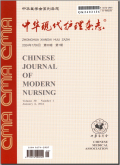基于重症超声监测胃残留量的肠内营养方案在肺移植患者中的应用
Effects of enteral nutrition program based on intensive ultrasound monitoring gastric residual on patients receiving lung transplantation
摘要目的探讨基于重症超声监测胃残留量的肠内营养方案在肺移植患者中的应用效果.方法? 选取2016年1—12月某三级甲等医院行肺移植术的100例患者作为研究对象,按照随机数字表法将患者分为试验组和对照组,各50例.试验组采取重症超声监测胃残余量指导的肠内营养方案,对照组采用常规肠内营养方案,观察两组肠内营养应用指标和并发症.结果? 试验组胃残留量为(130.32±40.44)ml、营养中断率为6%、达到目标喂养量时间为(3.47±0.62)d,低于对照组的(198.13±40.25)ml、28%、(5.59±0.71)d,差异有统计学意义(t/χ2值分别为-2.341、8.575、2.193;P<0.05).试验组滴速为(87.00±10.59)ml/h,高于对照组的(55.00±12.69))ml/h,差异有统计学意义(t=6.121, P<0.05).试验组误吸发生率为4%,与对照组(6%)比较差异无统计学意义(χ2=0.298,P>0.05).试验组肠内营养反流发生率(10%)、腹泻发生率(10%)和气管插管再插管率(8%)均低于对照组(33%、26%、24%),差异有统计学意义(χ2值分别为6.250、4.336、4.762;P<0.05).结论? 基于重症超声监测胃残留量实施肠内营养方案更符合肺移植患者目标导向性护理,更快达到目标喂养量,改善肠内营养相关并发症.
更多相关知识
abstractsObjective? To explore the effects of enteral nutrition program based on intensive ultrasound monitoring gastric residual on patients receiving lung transplantation. Methods? Totally 100 patients who received lung transplantation in a Class Ⅲ Grade A hospital between January and December 2016 were selected and divided into the treatment group (n=50) and the control group (n=50) according to the random number table. Patients in the treatment group received enteral nutrition based on intensive ultrasound monitoring gastric residual, while patients in the control group received conventional enteral nutrition. The indicators of enteral nutrition application and complications were observed in both groups. Results? The gastric residual of the treatment group was (130.32±40.44) ml; the nutrition interruption rate was 6%; the time for achieving the target feed volume was (3.47±0.62) d, lower than those of the control group (t/χ2=-2.341, 8.575, 2.193;P< 0.05), which were (198.13±40.25) ml, 28% and (5.59±0.71) d. The dripping speed of the treatment group was (87.00±10.59) ml/h, higher than that of the control group (t=6.121, P<0.05). The incidence rate of aspiration of the treatment group was 4%, and there was no statistically significant difference compared with that of the control group (χ2=0.298; P>0.05), which was 6%. The incidence rates of enteral nutrition reflux, diarrhea and reintubation rates of the treatment group were 10%, 10% and 8%, respectively, lower than those of the control group (33%,26%,24%) (χ2=6.250, 4.336, 4.762; P< 0.05) . Conclusions? The enteral nutrition program based on intensive ultrasound monitoring gastric residual conforms to target-oriented nursing care for patients receiving lung transplantation, which helps to achieve the target feed volume more quickly and ameliorate enteral nutrition-related complications.
More相关知识
- 浏览209
- 被引19
- 下载459


相似文献
- 中文期刊
- 外文期刊
- 学位论文
- 会议论文



 换一批
换一批 换一批
换一批



